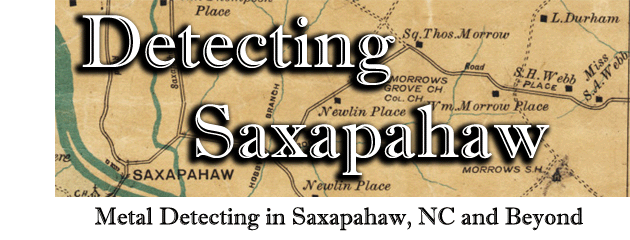I will start outside of chronological order with my most recent hunt at a Yankee Cavalry camp with my friend Dustin. We have been blessed with a somewhat unseasonably warm winter this year (which aids in my ability to get out and swing), but parts of it have gone from wet to just plain soaked. The result? Detecting in a thick, soupy, mess of sticky brown mud. YUCK! I know I've come out of the woods looking somewhat akin to Swamp Thing - pants and gloves covered with the stuff, pinpointer and shovel all but camouflaged, and boots heavy with a thick layer of stuck-on mud. There were some targets I had difficulty recovering, as the holes were filling with water just as quick as I could remove it.
Me after a day of diggin' in the mud!
But of course, when I get done detecting on a wet Winter day, I have the luxury of heading home to a nice hot shower in a well insulated (and centrally heated) house. Not so the soldiers who slept in the the camp I was detecting. Those cavalrymen had no such luxury, and I don't envy the camp lifestyle. I find it interesting the number of references to the weather in the various accounts and regimental histories I read. Over and over again are mentions of the thick mud that comes with the heavy rains, and the hardships it created for the soldiers in the field.
Dragging Artillery Through the Mud, Huntsville Alabama.
Harper's Weekly, March 19, 1864
Harper's Weekly, March 19, 1864
Perhaps the most famous (but by no means the only) instance of the weather affecting the course of the war was Burnside's infamous "Mud March". In January of 1863, Union General Ambrose Burnside attempted a crossing of the Rappahanock River in an attempt to surprise the Confederates and regain the initiative in the war. Torrential downpours turned the route to an impassable, muddy mess, stalling the Union army in it's tracks. After three days, the attempt was abandoned, and Burnside was promptly replaced from command by General Joseph Hooker.
My finds for the day - a good variety of bullets
Back to my own muddy quagmire - despite the conditions on the ground, we had a very successful day recovering relics from the War. I ended up recovering a nice variety of bullets, including Sharps Carbine, Sharps and Hankins, Smith Carbine, a Merrill Carbine, a Washington Arsenal three ring Minie (the first three ringer from this camp!), and a large number of colt pistol bullets. The brass finds included the back end of a cavalry spur with iron rowel, two links from a curb chain, a belt or tack stud, an epaulette turnkey, and quite a few bases from brass Sharps and Hankins cartridges. Both Dustin and I recovered coins from the camp - mine a war-date Indian Head Penny, and his an 1817 large cent.
The Indian Head penny was too corroded on the front to read a date,
but the thickness tells me it a war-date. Brass spur point and iron rowel.
but the thickness tells me it a war-date. Brass spur point and iron rowel.
I will leave you with a couple of tips I've picked up for wet, cold weather detecting. Both revolve around one simple concept - it's much easier to stay warm if you can stay dry. My friend Phil taught me the first trick at the snowy Spillman Farm hunt last year - wearing a pair of latex or nitrile gloves between my regular gloves and my hands. My regular digging gloves will eventually soak through, but the latex keeps my hands underneath dry, and thus considerably warmer. Simple, but incredibly effective. The next trick involves keeping my knees dry (and again, avoiding my pants from soaking through and exposing my legs to the cold). Some folks swear by knee pads, but I find them bulky and aggravating. Instead, I simply kneel on my digging shovel when I go down to explore a hole. This keeps my pants knees off of the wet ground, keeping me warmer for longer. I don't have to carry around anything special to kneel on, and no bulky knee pads. Of course this trick won't work in manicured lawns where only a hand-digger is appropriate, but in fields or woods it works wonders to keep me going in wet winter weather.
A simple yet effective way to stay dry and warmer in wet conditions.
Until next time, thanks for reading!


